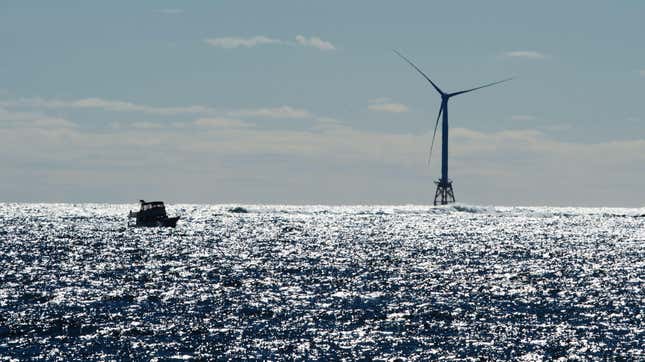
Rep. Raul Grijalva introduced a House bill yesterday that, if passed, would make oceans a central piece of climate policy. The legislation includes many good and important ideas, including stopping all offshore oil and gas drilling, pouring resources into marine ecosystem restoration, making fisheries more climate resilient, and allocating funds for Indigenous communities’ climate resilience efforts. Crucially, the bill also aims to ramp up America’s offshore wind production. But the goals it sets show how much bigger we need to be thinking when it comes to renewable energy.
The U.S. is already a huge laggard on offshore wind. Europe has 105 offshore wind farms in operation that produce about 18.5 gigawatts of power. Meanwhile, over here, we’ve only got one up and running, and it produces just 30 megawatts—or three one-hundredths of a gigawatt.
Grijalva’s bill aims to up that production to 25 gigawatts by 2030, with an intermediate goal of 12.5 gigawatts by 2025. Based on current production, that looks like a pretty ambitious target. But dig a little deeper, and it’s clear the U.S. could be aiming much higher. American offshore wind energy generation potential is ginormous. According to the Department of Energy, U.S. shores could yield more than 2,000 gigawatts of power. That’s nearly double the country’s current total electricity use.
The 25 gigawatt target is such a small fraction of that total that could be tapped. It’s also a fraction of what other countries are planning. The UK, for instance, recently committed to producing 40 gigawatts of offshore power by 2030. By proportion, that’s not as big a leap as the new House bill is proposing; the UK’s target would mean quadrupling the country’s offshore generation in 10 years, whereas the new bill would require increasing the U.S.’s by more than 800-fold.
But a shoddy past production record is still no excuse for not being more ambitious in the future, especially with so much potential waiting to be tapped. Instead, decision makers should heed leading scientists’ warnings that we need to get off oil and gas as soon as possible, and the fact that offshore wind could play a huge role in helping us do so.
There are big advantages to building out the offshore sector beyond not frying the climate. It’s been resilient to the recent fuel market crash, meaning it’s a safe investment. The offshore wind market is booming, and with no help from the the Trump administration, which has repeatedly delayed the approval process for proposed offshore wind farms in Maryland, Massachusetts, Rhode Island, and elsewhere. Offshore wind is also far more reliable and less intermittent than onshore wind or solar power, meaning its output is less affected by changes in the weather. And as the new bill shows, the sector also has the potential to create tens of thousands of jobs.
Though Grijalva’s proposal is clearly a step in the right direction for offshore wind production, we need to start making far larger strides. The U.S. is the number one contributor to historical emissions of greenhouse gases and uses more energy per capita than most other countries. It’s past time to get serious about making sure we transition off of dirty, planet-warming sources, and one of the most important ways to do that is to harness the power of our shores.